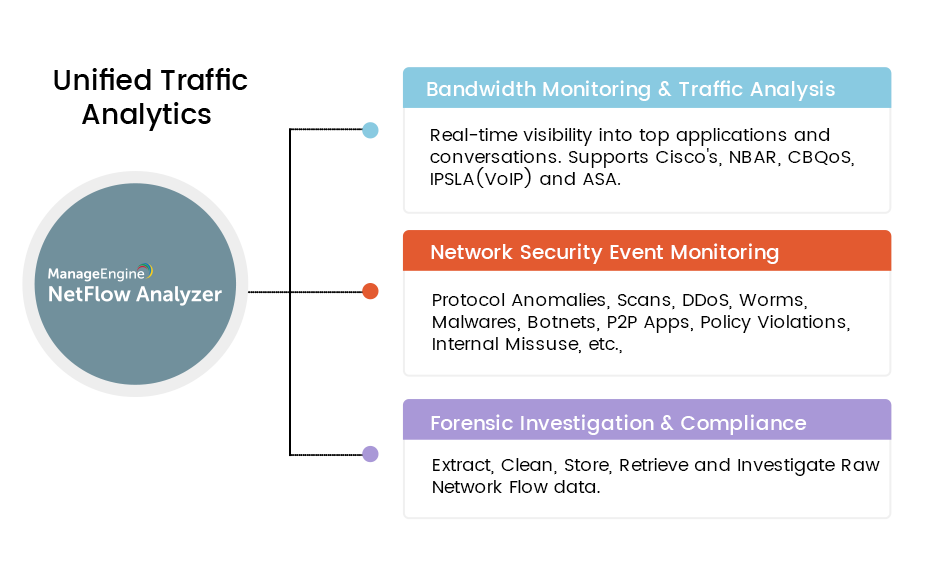Building firewalls and using simple security solutions is not enough to protect networks from a network anomaly or attack anymore, as DDoS attacks, unknown malware, and other security threats have been on the rise, altering network security landscapes. Network administrators have to work proactively to analyze their network, gain total control over it, and get a complete understanding of network traffic activity.
Network security attacks can be passive—where the attacker accesses, monitors, or steals sensitive data—or active, where the attacker not only gains access to this data but also encrypts, changes, or permanently deletes it. These can be endpoint attacks, malware, vulnerability exploits, or advanced persistent threats. The most common security threats that can put a network in jeopardy include:
1. DoS attacks
In a denial-of-service (DoS) attack, the attacker makes a machine or network resource inaccessible to its intended users by briefly or indefinitely breaching the connected host’s services. This cyberattack is executed by swarming the intended target machine or resource with a huge number of requests to overload systems.
2. DDoS attacks
A distributed denial-of-service (DDoS) attack is a more severe form of a DoS attack where the traffic flooding the victim is generated from multiple different sources, making it effectively impossible to stop the attack by simply blocking a single source.
3. Port scans
A port scan is a method attackers use to monitor and identify vulnerable services and ports running on a target machine so they can then plan an attack on them. This is the most common type of network probe.
4. Botnets
A botnet is a network of devices that are infected and run by one or more bots, known as bot herders. Once they are compromised, devices or botnets can be used to steal data, send spam, allow the attacker to access devices and their connections, or perform a DDoS attack.
Most enterprises rely on traditional security systems like firewalls and intrusion detection systems. Unfortunately, security threats are growing stronger and more complex every day and can easily bypass these solutions. Traditional security tools also typically overlook internal threats, which can be just as damaging to networks. The only solution for timely network anomaly detection and mitigation of these attacks before they affect the network and end users is a complete network traffic monitoring solution, and not just a network anomaly detection software, that leverages network behavior analysis.
A network behavior analysis (NBA) system, also known as a network behavior anomaly detection (NBAD) system, offers a more advanced approach to network security. It complements security analytics systems by offering in-depth visibility into a network's behavior patterns. Network Anomaly Detection tools or systems closely monitor networks to analyze conversations, diagnose network anomalies, and identify any attack or threat that may have bypassed the firewall.
NetFlow Analyzer provides an answer to the challenge of detecting network anomalies with its Advanced Security Analytics Module (ASAM) and Forensics report. It analyzes network behavior and establishes a performance baseline using built-in algorithms to help network admins detect security breaches quickly and effectively.

ASAM uses ManageEngine's Continuous Stream Mining Engine to proactively monitor and analyze bandwidth usage trends and network traffic behavioral patterns, detect network anomalies, and ensure the network does not remain vulnerable to unknown malware, zero-day intrusions, DDoS attacks, port scans, and other internal or external security threats.

The Forensics report passively monitors historical data and conversations to identify anomalous behavior, recurring spikes, and bandwidth hogs. It offers visibility into network details, such as traffic, application, source and destination IP, DSCP, TCP flags, and top conversations, for any selected time period. This helps network admins in network anomaly detection and identify the root cause of network issues and anomalies for faster troubleshooting.
Learn more on our Advanced Security Analytics Module and how it can keep your network secure.
Register for a free, personalized demo now!

NetFlow Analyzer is a comprehensive, flow-based, and highly scalable bandwidth monitoring and network traffic analysis tool. It doubles as a security analytics and network behavior anomaly detection tool and helps you gain in-depth visibility into your network devices, interfaces, apps, conversations, bandwidth usage, and network traffic; this insight makes it easier to diagnose and troubleshoot network security threats. Further, it comprises all the top key must-have features of network behavior anomaly detection tools. NetFlow Analyzer is part of the ManageEngine ITOM suite, and it monitors all major devices and flow formats, such as NetFlow, sFlow, J-Flow, IPFIX, and AppFlow.

NetFlow analyzer, it speaks for itself. It gives us a good insight into what's happening on the network. The security team and network team use it quite extensively. It's a great product, easy to use.
Community Media
NetFlow Analyzer boasts a rich set of features that align well with its intended purpose. The ability to collect, monitor, and analyze NetFlow, sFlow, J-Flow, and other flow data from various devices. The tools provide in-depth traffic analysis, top talkers, application protocols, and overall network performance helping identify bandwidth hogs and potential bottlenecks.
IT Services Industry
The tool best for real-time monitoring of network traffic to view bandwidth usage and network performance. Monitor traffic by protocol, allowing understanding of how different protocols are affecting the network. Source/Destination Analysis visibility into traffic patterns by source and destination IP addresses, aiding in identifying network congestion source.
IT Services Industry